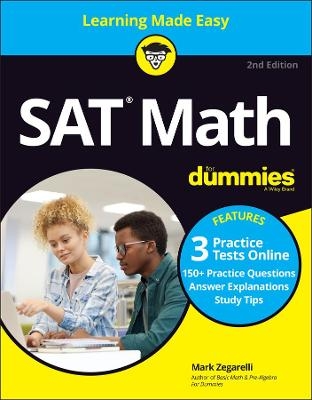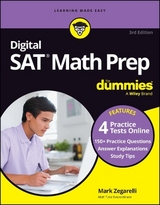
SAT Math For Dummies with Online Practice
For Dummies (Verlag)
978-1-119-82836-5 (ISBN)
A great math score on the SAT can unlock countless opportunities, especially in the STEM fields. With the help of SAT Math For Dummies, you’ll have what it takes to succeed on this challenging section of the exam. This helpful guide offers the tools and techniques you need to hone your strengths, eliminate your weaknesses, and walk into the testing room poised and prepared to conquer the math section of the SAT.
You’ll learn to tackle basic and advanced algebra, geometry, and trigonometry—with and without a calculator, just like you’ll need to do on the test. The book also offers intuitive reviews of critical math concepts and skills – like evaluating, simplifying, and factoring algebra expressions – while preparing you for common pitfalls and traps that ensnare less prepared students.
This up-to-date resource will help you:
Reduce test anxiety and stress by preparing with resources that mirror the tasks you’ll have to perform on test day
Master the time-management and other test-taking strategies you’ll need to get the results you want
Prove you’re ready for the test by practicing with online resources that include three complete practice tests
Effective practice and preparation are the keys to succeeding on the math section of the SAT. And with SAT Math For Dummies in your arsenal, you’ll have the strategies, knowledge, and skills that make extraordinary results possible.
Mark Zegarelli is a math teacher and tutor. He graduated with degrees in math and English from Rutgers University. He has written a variety of educational books, including Basic Math & Pre-Algebra For Dummies.
Introduction 1
About This Book 1
Foolish Assumptions 2
Icons Used in This Book 2
Beyond the Book 3
Where to Go from Here 3
Part 1: Getting Started with Sat Math 5
Chapter 1: Welcome to SAT Math 7
SAT Math Basics 8
Using the Reference list of formulas 8
Filling answers into the grid 8
Overview of SAT Math Topics 10
Heart of Algebra 10
Problem Solving and Data Analysis 10
Passport to Advanced Math (and Other Topics) 10
SAT Math Strategy 11
Isn’t there some way to get a good SAT Math score without actually knowing math? 11
Is there a penalty for guessing? 11
Are some questions harder than others? 12
Do I have to answer every question? 12
So, how many questions should I answer? 13
When’s the latest I can take the SAT and still get into school? 14
Hey wait — do I even have to take the SAT to go to college? 14
Three SAT Success Stories 15
Jay’s story — clearing 500 15
Shaun’s story — breaking solidly beyond 600 15
Amy’s story — reaching 700 and beyond 16
Chapter 2: Review of Pre-Algebra 17
Sets of Numbers 17
Natural numbers 18
Integers 18
Rational numbers 18
Real numbers 18
Complex numbers 19
Fractions, Ratios, Decimals, and Percentages 19
Review of fractions and ratios 19
Review of decimals and percentages 22
Absolute Value 22
Radicals 23
Understanding radicals 23
Multiplying and dividing radicals 24
Simplifying radicals 25
Adding and subtracting radicals 25
Rationalizing radicals in the denominator 26
Understanding Algebra Terminology 27
Algebra and arithmetic 27
Equations, identities, and inequalities 28
Expressions 28
Polynomial basics 29
Graphing on the xy-Plane 31
Understanding the axes, the origin, and the quadrants 31
Plotting coordinates on the xy-plane 31
Plotting equations on the xy-plane 32
Choosing and Using a Calculator 33
Knowing which calculators to avoid on the SAT 33
Choosing a calculator 33
Knowing some basic calculator moves 34
Getting familiar with a few advanced calculator moves 34
Part 2: Conquering the Heart of Algebra 37
Chapter 3: Algebra I Reboot Part 1: Expressions 39
Evaluating Expressions 40
Simplifying Expressions 40
Combining like terms 41
Distributing to remove parentheses 41
FOILing to multiply the contents of parentheses 42
Factoring Expressions 43
GCF Factoring 43
Difference of squares 44
Sum and difference of cubes 47
Factoring quadratic trinomials 48
Factoring cubic expressions 50
Chapter 4: Algebra I Reboot Part 2: Equations and Inequalities 53
Solving Simple and Intermediate Algebra Equations 54
Solving basic algebra equations 54
Working with equations that have more than one variable 55
Solving More Difficult Equations 58
Solving quadratic equations 58
Solving rational equations 62
Solving Inequalities 64
Using equation-solving skills with inequalities 64
Knowing when to flip the inequality sign 65
Lining up inequalities to solve systems 65
Chapter 5: Linear Functions 67
Interpreting Linear Functions as Words, Tables, Graphs, and Equations 68
Understanding linear functions in four complementary ways 68
Answering SAT questions about linear functions 70
Linear Function Basics 71
Slope-intercept form 72
Standard form 73
Using Two Formulas to Find the Slope 77
Measuring the slope of a graph 77
Measuring slope using two points 79
Solving Linear Function Problems 79
Finding the equation when you have two pieces of information 80
Understanding problems with parallel and perpendicular lines 81
Solving Word Problems 84
Angela’s flowers 84
Peter’s autos 84
Jacqueline’s ascent 85
Chapter 6: Systems of Equations 87
Systems of Linear Equations 87
Solving systems of linear equations 88
Looking for a fast solution 90
Solving word problems with a system of linear equations 92
Working with Problematic Systems of Equations 94
Understanding systems with one solution 94
Troubleshooting problematic systems 95
Understanding what makes a system problematic 97
Answering SAT questions about problematic systems 97
Systems of Linear Inequalities 98
Setting up systems of linear inequalities to solve word problems 98
Graphs with linear inequalities 99
Systems of Non-Linear Equations 102
Part 3: Tackling Problem Solving and Data Analysis 105
Chapter 7: Ratios, Proportions, and Percentages 107
Understanding Ratios and Proportions 107
Understanding ratios 108
Creating proportional equations 108
Using Ratios and Proportions to Solve SAT Word Problems 109
Solving unit conversion problems 109
Using population density in a proportional equation 110
Answering questions involving similar triangles 111
Understanding direct proportionality 112
Using Percentages to Answer SAT Questions 113
Setting up equations to solve percentage problems 113
Solving percent increase and percent decrease problems 114
Chapter 8: Statistics and Probability 119
Statistics 119
Statistical calculations 120
Collecting data and interpreting statistics 122
Probability 125
Understanding the probability formula 125
Answering SAT probability questions 125
Answering table-based SAT probability questions 126
Chapter 9: Understanding Data and Information from Tables and Graphs 129
Reading Information from Tables 129
Understanding Bar Graphs, Histograms, and Dot Plots 130
Bar graphs 131
Histograms 132
Dot plots 132
Working with Line Graphs and Scatterplots 134
Mapping time with line graphs 134
Understanding scatterplots 134
Part 4: Your Passport to Advanced Math 137
Chapter 10: Functions 139
Understanding Function Notation 139
Evaluating a function by plugging in a number 140
Evaluating a function plus or minus a value 140
Evaluating a function times or divided by a value 141
Evaluating a function by plugging in a variable or an expression 142
Working with Function Notation 143
Combining functions 143
Compositions of functions 145
Inverse functions 146
Using the Vertical Line Test for Functions 147
Knowing Some Key Parent Functions 149
Polynomial functions 149
Other important parent functions 151
Transforming Functions 154
Clarifying vertical and horizontal transformations 154
Understanding stretch-compress-flip transformations 158
Working with all three types of transformations 160
Chapter 11: Polynomials 163
Knowing Polynomial Basics 163
Looking at the leading term 164
Using the constant term to find the y-intercept 167
Identifying Odd and Even Polynomials 167
Identifying odd and even functions 167
Spotting end behavior as x approaches 168
Finding the x-Intercepts of Polynomials 169
Knowing a few names for x-intercepts 169
Finding the x-intercepts of a polynomial in factored form 170
Finding the x-intercepts of a polynomial in standard form 170
Sketching the Graph of a Polynomial 171
Sketching a polynomial from its factored form 171
Sketching “bounce” x-intercepts 173
Sketching a polynomial from its standard form 175
Equivalent Polynomials 177
Recalling Synthetic Division for Polynomials 178
Chapter 12: Quadratic Functions 179
The Quadratic Function in Standard Form 180
Understanding standard-form quadratic functions 180
Sketching a parabola from standard form 184
The Quadratic Function in Vertex Form 186
Understanding vertex form quadratic functions 186
Sketching a parabola from vertex form 191
Connecting Standard and Vertex Forms 194
Changing vertex form to standard form 194
Changing standard form to vertex form 195
Finding the Roots of a Quadratic Function 198
Distinguishing quadratic functions from quadratic equations 198
Identifying quadratic functions with 2, 1, and no x-intercepts 199
Using the discriminant to count x-intercepts 200
Finding the roots of a quadratic function 201
Using quadratic equations to solve word problems about projectiles 203
Chapter 13: Exponential and Radical Equations 207
Solving Exponential Equations 207
Using exponential identities 208
Solving exponential equations 209
Answering SAT Math Questions Using Exponential Functions 211
Understanding exponential growth 211
Working with exponential decay 214
Graphing Exponential Functions 217
Radical Equations and Functions 220
Solving radical equations 220
Graphing radical functions 221
Chapter 14: Geometry and Trigonometry 225
Geometry 225
Geometric formulas for success 226
Knowing the angles 227
Isosceles triangles 229
Similar triangles 231
Working with right triangles 231
Trigonometry 237
Using SOH-CAH-TOA to understand sines, cosines, and tangents 237
Building a triangle from a single trig ratio 239
Applying trig ratios to special right triangles 240
Remembering the most important SAT identity 241
Radian measure and arc length 242
Chapter 15: Additional SAT Math Topics 245
Imaginary and Complex Numbers 245
The imaginary number i 246
Complex numbers 248
Circles on the xy-Plane 251
Circles in center-radius form 252
Plotting points on a circle on the xy-plane 254
Identifying interior and exterior points on a circle 255
Completing the square to solve difficult circle problems 256
Part 5: Practice Makes Perfect: Sat Math Section Practice Tests 257
Chapter 16: Practice SAT Math Test 1 259
Answer Sheet for Practice SAT Math Test 1 260
Section 3 — No Calculator 261
Section 4 — Calculator 265
Chapter 17: Answers and Explanations for Practice SAT Math Test 1 273
Section 3 — No Calculator 273
Section 4 — Calculator 277
Chapter 18: Practice SAT Math Test 2 289
Answer Sheet for Practice SAT Math Test 2 290
Section 3 — No Calculator 291
Section 4 — Calculator 296
Chapter 19: Answers to Practice SAT Math Test 2 305
Section 3 — No Calculator 305
Section 4 — Calculator 310
Part 6: The Part of Tens 321
Chapter 20: Ten Things You Will Almost Definitely See on Your SAT Math Test 323
Linear Functions 323
Systems of Linear Equations 324
Quadratic Functions 324
Percentages 324
Ratio/Proportion Problems 325
The Mean and the Median 325
The Trig Identity 325
The Quadratic Formula 326
The Imaginary Number i 326
Circles on the Graph 326
Chapter 21: Ten Tips to Improve Your SAT Math Score 327
Study Diligently in Your Math Classes 327
Get Good at Doing Basic Calculations in Your Head 328
Get Good at Using Your Calculator 328
Study SAT-Specific Math Skills 328
Get Comfortable Turning Words into Numbers 329
Take Timed Practice Tests 329
When Taking Practice Tests, Budget Your Time to Maximize Your Score 329
Study from Your Timed Practice Tests 330
Retake Your Timed Practice Tests 330
Take the SAT More than Once 330
Chapter 22: Ten Tips to Be at Your Best on the SAT 331
Do Something Fun the Day Before the Test 331
Don’t Study for More than 20 Minutes the Night Before the Test 331
Pack Everything You Need the Night Before 332
Do Something Relaxing Before Bed 332
Get a Good Night’s Sleep 332
Wear Several Layers of Clothing 333
Arrive at the Test Site Extra Early 333
Spend Your Time Just Before the Test However You Please 333
Remember to Breathe 333
Skip Over Any Questions That Throw You 333
Index 335
| Erscheinungsdatum | 30.11.2021 |
|---|---|
| Sprache | englisch |
| Maße | 216 x 274 mm |
| Gewicht | 680 g |
| Themenwelt | Sozialwissenschaften ► Pädagogik |
| ISBN-10 | 1-119-82836-8 / 1119828368 |
| ISBN-13 | 978-1-119-82836-5 / 9781119828365 |
| Zustand | Neuware |
| Informationen gemäß Produktsicherheitsverordnung (GPSR) | |
| Haben Sie eine Frage zum Produkt? |
aus dem Bereich



